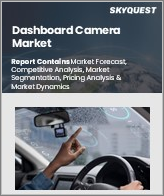
|
시장보고서
상품코드
1461357
세계의 대시보드 카메라 시장 : 현황 분석 및 예측(2023년-2030년)Dashboard Camera Market: Current Analysis and Forecast (2023-2030) |
||||||
대시보드 카메라(대시캠)(Dashboard Camera) 시장은 도로의 차량 수 증가와 차량 사고 증가로 인해 약 17.6%의 높은 CAGR로 성장할 것으로 예상됩니다. 대시보드 카메라 수요를 견인하는 주요 요인 중 하나는 도로 안전에 대한 관심이 증가하고 있다는 점입니다. 교통 사고가 계속해서 전 세계적으로 주요 이슈가 되면서 소비자들은 충돌이나 분쟁 발생 시 증거를 제공하기 위해 대시보드 카메라에 눈을 돌리고 있습니다. 또한, 보험 사기와 허위 청구에 대한 인식이 높아지면서 대시보드 카메라 수요가 증가하는 또 다른 요인으로 작용하고 있습니다. 대시보드 카메라 영상은 무죄를 입증하고 전 세계 여러 지역에서 만연한 문제가 되고 있는 보험 사기를 예방하는 데 중요한 증거로 사용될 수 있습니다. 예를 들어, 보험사기국의 연구에 따르면 2020년 영국 보험 업계는 보험 사기 청구로 인해 약 14억 1,000만 달러의 손실을 입은 것으로 추정됩니다. 또한, 기술의 발전으로 대시보드 카메라가 더욱 저렴하고 사용자 친화적으로 바뀌면서 글로벌 시장에서 대시보드 카메라의 수요가 더욱 증가하고 있습니다. 최신 대시보드 카메라에는 GPS 추적, 충격 감지를 위한 G-센서, 영상에 쉽게 액세스할 수 있는 클라우드 스토리지 등의 기능이 탑재된 제품이 많습니다. 덕분에 대시보드 카메라는 안전 장치뿐만 아니라 운전 습관 및 차량 보안을 모니터링하는 편리한 도구로 자리 잡았습니다. 또한, 대시보드 카메라 영상을 공유하는 소셜 미디어 플랫폼과 온라인 커뮤니티의 등장도 대시보드 카메라에 대한 수요 증가에 기여했습니다. 대시보드 카메라에 포착된 아찔한 상황, 사고, 특이한 사건에 대한 바이럴 영상이 온라인에서 수백만 건의 조회수를 기록하면서 운전자들 사이에서 대시보드 카메라 사용이 더욱 대중화되고 있습니다.
기술 유형에 따라 시장은 기본, 고급 및 스마트로 분류됩니다. 스마트 대시보드 카메라는 예상 기간 동안 상당한 성장을 보일 것으로 예상됩니다. 스마트 대시보드 카메라의 광범위한 채택의 주요 요인은 고급 기능입니다. 스마트 대시보드 카메라에는 GPS 추적, Wi-Fi 연결 및 스마트폰 통합과 같은 고급 기능이 탑재되어 있습니다. 이러한 기능은 사용자에게 추가적인 기능과 편의성을 제공하여 스마트 카메라를 더욱 매력적으로 만듭니다. 또한 스마트 대시보드 카메라에는 차선 이탈 경고, 충돌 감지 및 실시간 알림과 같은 안전 기능이 함께 제공되는 경우가 많습니다. 이러한 기능은 운전자가 도로에서 안전을 유지하는 데 도움이 되므로 안전에 민감한 소비자들 사이에서 스마트 카메라가 인기 있는 선택입니다. 또한, 스마트 대시보드 카메라는 영상을 클라우드에 저장하여 사용자가 원격으로 녹화 영상에 액세스할 수 있는 경우가 많습니다. 이 기능은 녹화 영상을 안전하게 보호하고 어디서나 액세스하려는 사용자에게 특히 매력적입니다. 또한 스마트 대시보드 카메라는 다른 장치 및 애플리케이션에 연결하여 전반적인 기능을 향상시킬 수 있습니다. 스마트폰, 태블릿 및 기타 스마트 장치와의 통합으로 스마트 카메라는 더욱 다양한 용도로 사용할 수 있으며 더 많은 소비자에게 어필할 수 있습니다.
채널 유형에 따라 시장은 싱글 채널과 더블 채널로 세분화됩니다. 싱글 채널이 시장 점유율의 대부분을 차지하고 있습니다. 싱글 채널 대시보드 카메라가 널리 채택된 주요 요인은 비용 효율성입니다. 싱글 채널 대시보드 카메라는 일반적으로 더블 채널 대시보드 카메라보다 더 저렴합니다. 가격대가 낮기 때문에 더 많은 소비자들이 더 쉽게 접근할 수 있어 판매량과 시장 점유율이 높아집니다. 또한, 싱글 채널 대시보드 카메라는 더블 채널에 비해 설치 및 작동이 간단하기 때문에 사용 편의성을 중시하는 소비자에게 더 매력적입니다. 간단한 기능 덕분에 더 많은 고객층을 확보할 수 있습니다. 또한 단일 채널 대시보드 카메라는 종종 더 컴팩트한 디자인으로 차량에서 눈에 덜 띄고 미적으로도 만족스러운 경우가 많습니다. 이는 눈에 잘 띄지 않고 눈에 거슬리지 않는 설정을 선호하는 소비자들에게 어필할 수 있습니다. 또한 단일 채널 카메라는 일반적으로 대시보드 카메라의 주요 기능인 전방 도로의 비디오 영상 녹화에 중점을 둡니다. 이러한 단순한 기능은 부가 기능보다 핵심 기능을 우선시하는 소비자들의 공감을 불러일으킵니다.
차종에 따라 시장은 승용차와 상용차로 양분됩니다. 대시보드 카메라 수요는 상용차 부문에서 가장 빠른 성장세를 보이고 있습니다. 대시보드 카메라 수요를 촉진하는 주요 요인 중 하나는 강화된 안전 조치의 필요성입니다. 상용차와 관련된 교통사고 및 사건이 증가함에 따라 차량 운영자는 운전자 행동을 모니터링하고 위험한 운전 습관을 식별하며 사고를 예방하기 위해 점점 더 대시보드 카메라 카메라에 의존하고 있습니다. 예를 들어, 미국 도로교통안전국(NHTSA)의 보고서에 따르면 사고의 94%는 사람의 실수로 인해 발생한다고 합니다. 대시보드 카메라는 사고 및 분쟁 발생 시 구체적인 증거를 제공함으로써 이러한 위험을 완화하는 데 도움이 될 수 있습니다. 또한 규정 준수의 중요성이 커지는 것도 상용차에서 대시보드 카메라를 채택하는 또 다른 이유입니다. 미국의 전자 기록 장치(ELD) 규정과 EU의 다양한 안전 규정은 상업용 차량이 정확한 주행 시간 기록을 유지하고 안전 표준을 준수하도록 요구합니다. GPS 추적 및 운전자 모니터링 기능이 탑재된 대시보드 카메라 카메라는 차량 관리자가 이러한 규정을 준수하고 벌금을 피할 수 있도록 도와줍니다. 안전 및 규정 준수 외에도 대시보드 카메라 카메라는 차량 운영자의 운영 효율성을 개선하고 비용을 절감하는 역할도 담당하고 있습니다. 차량 성능, 연료 소비 및 경로 최적화에 대한 실시간 가시성을 제공함으로써 차량 관리자는 정보에 입각한 의사 결정을 내릴 수 있어 비용 절감과 생산성 향상으로 이어질 수 있습니다. 예를 들어, 일부 연구에 따르면 대시보드 카메라와 같은 차량용 텔레매틱스 솔루션은 연료 소비를 최대 10%까지 줄이고 유지보수 비용을 14%까지 절감할 수 있다고 합니다. 또한 보험 사기와 허위 청구의 증가로 인해 상용차 대시보드 카메라에 대한 수요가 증가하고 있습니다. 최근 몇 년 동안 상용차를 대상으로 한 보험금 사기 및 고의 사고가 급증했습니다. 대시보드 카메라는 허위 청구를 반박하고 재정적 손실로부터 기업을 보호할 수 있는 신뢰할 수 있는 증거 자료로 활용됩니다.
대시보드 카메라 시장 도입에 대한 이해를 높이기 위해 시장은 북미(미국, 캐나다, 기타 북미), 유럽(독일, 영국, 프랑스, 스페인, 이탈리아, 기타 유럽), 아시아 태평양(중국, 일본, 인도, 기타 아시아 태평양), 세계 기타 지역에서 지리적 존재를 바탕으로 분석됩니다. 북미는 시장 점유율의 대부분을 차지합니다. 북미는 기술 진보의 최전선에 있으며 대시보드 카메라의 채택도 예외는 아닙니다. 기술에 긍정적인 소비자층과 혁신을 중시하는 문화를 가진 북미 운전자는 대시보드 카메라의 자동차 사용을 용이하게 받아들입니다. 게다가 북미 소비자들에게 안전과 보안이 가장 중요하며 대시보드 카메라는 도로에서 보호 레이어를 추가합니다. 교통사고나 부정한 보험금 청구가 다발하고 있기 때문에 북미의 드라이버는 대시보드 카메라에 투자해, 만일의 사고에 대비해 중요한 영상을 촬영하게 되었습니다. 예를 들어 미국 도로 안전보험협회(Insurance Institute for Highway Safety)의 보고서에 따르면 2021년 북미에서는 대시보드 카메라가 보험금 청구의 72% 이상을 해결하는 데 도움이 되었습니다. 또한 북미에서는 대시보드 카메라의 사용을 지원하는 법적 틀이 확립되었습니다. 캘리포니아와 온타리오를 포함한 여러 주와 지방에서는 대시보드 카메라의 영상이 교통 관련 사건의 증거로 법정에서 인정됩니다. 이러한 법적 지원이 북미 운전자에게 대시보드 카메라의 탑재를 촉구해 시장 수요 급증으로 이어지고 있습니다.
이 주요 시장 진출기업은 Valeo, Aptiv, Honeywell International Inc., Panasonic Corporation, Garmin Ltd., Koninklijke Philips NV, DOD Tech, Waylens, Inc., LG Innotek, Pittasoft Co.Ltd. 등을 포함합니다.
목차
제1장 시장 소개
- 시장 정의
- 주요 목표
- 이해관계자
- 제한 사항
제2장 조사 방법 또는 전제 조건
- 조사 과정
- 조사 방법
- 응답자 프로파일
제3장 시장 개요
제4장 주요 요약
제5장 COVID-19가 대시보드 카메라 시장에 미치는 영향
제6장 대시보드 카메라 시장 매출(2020-2030년)
제7장 시장 분석 : 기술별
- 기본
- 어드밴스드
- 스마트
제8장 시장 분석 : 채널 유형별
- 싱글 채널
- 듀얼 채널
제9장 시장 분석 : 차종별
- 승용차
- 상용차
제10장 시장 분석 : 지역별
- 북미
- 미국
- 캐나다
- 기타 북미
- 유럽
- 독일
- 영국
- 프랑스
- 이탈리아
- 기타 유럽
- 아시아 태평양
- 중국
- 인도
- 일본
- 한국
- 기타 아시아 태평양
- 세계 기타 지역
제11장 대시보드 카메라 시장 역학
- 시장 성장 촉진 요인
- 시장 과제
- 영향 분석
제12장 대시보드 카메라 시장 기회
제13장 대시보드 카메라 시장 동향
제14장 수요 및 공급 분석
- 수요측 분석
- 공급측 분석
제15장 밸류체인 분석
제16장 경쟁 시나리오
- 경쟁 구도
- Porter's Five Forces 분석
제17장 기업 프로파일
- Valeo
- Aptiv
- Honeywell International Inc.
- Panasonic Corporation
- Garmin Ltd
- Koninklijke Philips NV,
- DOD Tech
- Waylens, Inc.
- LG Innotek
- Pittasoft Co. Ltd.
제18장 면책사항
LYJ 24.04.16A dashboard camera, commonly known as a dash cam, is a compact video camera mounted on the dashboard or windshield of a vehicle to continuously record the view through the front windshield as well as the interior of the car. Dash cams are designed to capture high-quality video footage and audio recordings of the road ahead, helping to document accidents, unexpected events, and driving behavior. By providing a real-time and reliable record of what occurs on the road, dashboard cameras serve as a valuable tool for ensuring road safety, aiding in insurance claims, providing evidence in legal disputes, and monitoring driving habits. They have become increasingly popular among drivers as a means of protecting themselves and their vehicles while on the road.
The Dashboard Camera Market is expected to grow at a strong CAGR of around 17.6% owing to the growing number of vehicles on roads and increasing vehicle accidents. One of the key factors driving the demand for dashboard cameras is the increasing concern for road safety. As road accidents continue to be a major global issue, consumers are turning to dash cams as a way to provide evidence in the event of a crash or dispute. Furthermore, another factor contributing to the rising demand for dashcams is the growing awareness of insurance fraud and false claims. Dash cam footage can serve as crucial evidence in proving innocence and preventing insurance fraud, which has become a prevalent issue in many parts of the world. For instance, a study by the Insurance Fraud Bureau found that fraudulent insurance claims cost the UK insurance industry an estimated USD 1.41 billion in 2020. Moreover, the advancements in technology have made dashcams more affordable and user-friendly, further fuelling their demand in global markets. Many modern dashcams come equipped with features such as GPS tracking, G-sensors for impact detection, and cloud storage for easy access to footage. This has made dash cams not only a safety device but also a convenient tool for monitoring driving habits and vehicle security. Furthermore, the emergence of social media platforms and online communities dedicated to sharing dashcam footage has also contributed to the growing demand for these devices. Viral videos of near-misses, accidents, and unusual events captured by dashcams have garnered millions of views online, further popularizing the use of these devices among drivers.
Based on technology type, the market is categorized into basic, advanced, and smart. The smart dashboard camera is anticipated to experience substantial growth in the predicted timeframe. The primary factor for this widespread adoption of the smart dashboard camera is its advanced features. Smart dashboard cameras come equipped with advanced features like GPS tracking, Wi-Fi connectivity, and smartphone integration. These features provide users with added functionalities and convenience, making smart cameras more appealing to consumers. Furthermore, Smart dashboard cameras often come with safety features such as lane departure warnings, collision detection, and real-time alerts. These features help drivers stay safe on the road, making smart cameras a popular choice among safety-conscious consumers. Moreover, Smart dashboard cameras can often store footage on the cloud, allowing users to access their recordings remotely. This feature is especially attractive to users who want to safeguard their recordings and access them from anywhere. Additionally, smart dashboard cameras can connect to other devices and applications, enhancing their overall functionality. Integration with smartphones, tablets, and other smart devices makes smart cameras more versatile and appealing to a wider range of consumers.
Based on channel type, the market is segmented into single channel and double channel. The single channel holds the majority of the market share. The primary factor for this widespread adoption of the single-channel dashboard camera is its cost-effectiveness. ingle-channel dashboard cameras are usually more affordable than double-channel ones. This lower price point makes them more accessible to a wider range of consumers, leading to higher sales and market share. Furthermore, single-channel dashboard cameras are simpler to install and operate compared to double-channel cameras, making them more appealing to consumers who prioritize ease of use. The straightforward functionality attracts a larger customer base. Moreover, single-channel dashboard cameras often have a more compact design, which makes them less obtrusive in the car and aesthetically pleasing. This appeals to consumers who prefer a discreet and unobtrusive setup. Additionally, single-channel cameras typically focus on recording video footage of the road ahead, which is considered the primary function of a dashboard camera. This simplicity in function resonates with consumers who prioritize the core features over additional functionalities.
Based on vehicle type, the market is bifurcated into passenger vehicles and commercial vehicles. The demand for the dashboard camera is witnessing the fastest growth from the commercial vehicle segment. One of the primary factors fueling the demand for dashboard cameras is the need for enhanced safety measures. With the rise in road accidents and incidents involving commercial vehicles, fleet operators are increasingly turning to dashboard cameras to monitor driver behavior, identify risky driving practices, and prevent accidents. For instance, according to a report by the National Highway Traffic Safety Administration (NHTSA), 94% of accidents are caused by human error. Dashboard cameras can help mitigate these risks by providing concrete evidence in case of accidents and disputes. Furthermore, the growing importance of regulatory compliance is another driving factor behind the adoption of dashboard cameras in commercial vehicles. Mandates such as the Electronic Logging Device (ELD) rule in the U.S. and various safety regulations in the EU require commercial vehicles to maintain accurate records of driving hours and comply with safety standards. Dashboard cameras equipped with GPS tracking and driver monitoring features help fleet managers ensure compliance with these regulations and avoid penalties. In addition to safety and compliance, dashboard cameras are also being embraced for their role in improving operational efficiency and reducing costs for fleet operators. By providing real-time visibility into vehicle performance, fuel consumption, and route optimization, these cameras enable fleet managers to make informed decisions that lead to cost savings and enhanced productivity. For instance, According to some studies, fleet telematics solutions such as dashboard cameras can help reduce fuel consumption by up to 10% and decrease maintenance costs by 14%. Moreover, the increasing prevalence of insurance fraud and false claims has propelled the demand for dashboard cameras in commercial vehicles. In recent years, there has been a surge in fraudulent claims and staged accidents targeting commercial vehicles. Dashboard cameras serve as a reliable source of evidence to refute false claims and protect businesses from financial losses.
For a better understanding of the market adoption of dashboard camera, the market is analyzed based on its worldwide presence in countries such as North America (The U.S., Canada, and the Rest of North America), Europe (Germany, The U.K., France, Spain, Italy, Rest of Europe), Asia-Pacific (China, Japan, India, Rest of Asia-Pacific), Rest of World. North America holds the majority of the market share. North America has been at the forefront of technological advancements, and the adoption of dashboard cameras is no exception. With a tech-forward consumer base and a culture that values innovation, North American drivers have readily embraced the use of dashboard cameras in their vehicles. Furthermore, safety and security are paramount for North American consumers, and dashboard cameras provide an added layer of protection on the roads. The prevalence of traffic accidents and fraudulent insurance claims has motivated drivers in North America to invest in dashboard cameras to capture crucial footage in case of incidents. For instance, the Insurance Institute for Highway Safety reported that in 2021, dashboard cameras helped resolve over 72% of disputed insurance claims in North America. Moreover, North America has a well-established legal framework that supports the use of dashboard cameras. In several states and provinces, including California and Ontario, dashboard camera footage is admissible in court as evidence in traffic-related cases. This legal support has encouraged drivers in North America to equip their vehicles with dashboard cameras, leading to a surge in market demand.
Some of the major players operating in the market include Valeo; Aptiv; Honeywell International Inc.; Panasonic Corporation; Garmin Ltd; Koninklijke Philips N.V.,; DOD Tech; Waylens, Inc.; LG Innotek; and Pittasoft Co. Ltd.
TABLE OF CONTENTS
1MARKET INTRODUCTION
- 1.1.Market Definitions
- 1.2.Main Objective
- 1.3.Stakeholders
- 1.4.Limitation
2RESEARCH METHODOLOGY OR ASSUMPTION
- 2.1.Research Process of the Dashboard Camera Market
- 2.2.Research Methodology of the Dashboard Camera Market
- 2.3.Respondent Profile
3MARKET SYNOPSIS
4EXECUTIVE SUMMARY
5IMPACT OF COVID-19 ON THE DASHBOARD CAMERA MARKET
6DASHBOARD CAMERA MARKET REVENUE (USD BN), 2020-2030F.
7MARKET INSIGHTS BY TECHNOLOGY TYPE
- 7.1.Basic
- 7.2.Advanced
- 7.3.Smart
8MARKET INSIGHTS BY CHANNEL TYPE
- 8.1.Single Channel
- 8.2.Dual Channel
9MARKET INSIGHTS BY VEHICLE TYPE
- 9.1.Passenger Vehicle
- 9.2.Commercial Vehicle
10MARKET INSIGHTS BY REGION
- 10.1.North America
- 10.1.1.The U.S.
- 10.1.2.Canada
- 10.1.3.Rest of North America
- 10.2.Europe
- 10.2.1.Germany
- 10.2.2.The U.K.
- 10.2.3.France
- 10.2.4.Italy
- 10.2.5.Rest of Europe
- 10.3.Asia-Pacific
- 10.3.1.China
- 10.3.2.India
- 10.3.3.Japan
- 10.3.4.South Korea
- 10.3.5.Rest of Asia-Pacific
- 10.4.Rest of the World
11DASHBOARD CAMERA MARKET DYNAMICS
- 11.1.Market Drivers
- 11.2.Market Challenges
- 11.3.Impact Analysis
12DASHBOARD CAMERA MARKET OPPORTUNITIES
13DASHBOARD CAMERA MARKET TRENDS
14DEMAND AND SUPPLY-SIDE ANALYSIS
- 14.1.Demand Side Analysis
- 14.2.Supply Side Analysis
15VALUE CHAIN ANALYSIS
16COMPETITIVE SCENARIO
- 16.1.Competitive Landscape
- 16.1.1.Porters Fiver Forces Analysis
17COMPANY PROFILED
- 17.1.Valeo
- 17.2.Aptiv
- 17.3.Honeywell International Inc.
- 17.4.Panasonic Corporation
- 17.5.Garmin Ltd
- 17.6.Koninklijke Philips N.V.,
- 17.7.DOD Tech
- 17.8.Waylens, Inc.
- 17.9.LG Innotek
- 17.10.Pittasoft Co. Ltd.



















